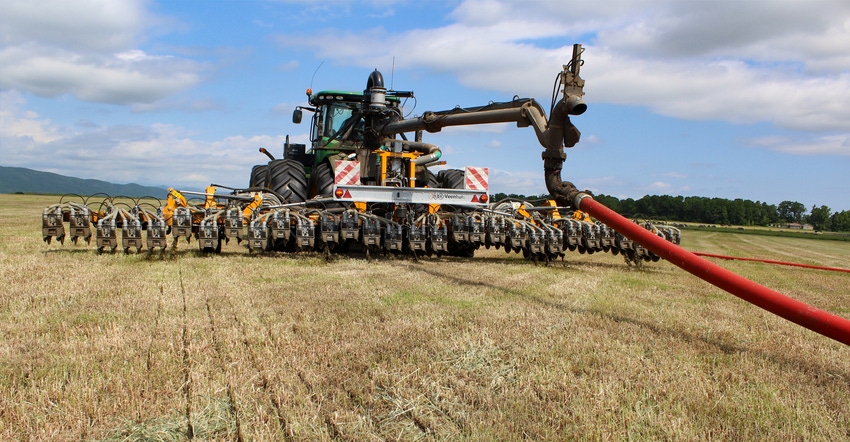July 12, 2018

New England farmers can identify with their kindred spirits in the mid-Atlantic. Both are discovering solutions to the difficult challenges of cleaning up the water feeding Lake Champlain, Chesapeake Bay and other critical fresh water sources.
Barnes' Black and White Face Farm, for example, lies just a quarter-mile from Lake Champlain — long plagued by phosphorus overload. Bill Barnes, like other Vermont farmers, has always been looking for ways to reduce P runoff from his fields.
This spring, the Bridport, Vt., farm hosted a field trial for a promising method — injecting liquid manure into grassland to reduce runoff risk of dissolved P. A shallow-slot manure injector, purchased by University of Vermont Extension, was demonstrated on Barnes' hayfields.
Barnes, who milks 1,500 cows on three farms with his son Dan, appreciates the odor reduction, plus the potential for better water quality. "It's putting manure in [under the surface] a little bit — better than splashing it on top," says the Addison County producer. "Anything that puts it under is better than leaving it on top." But he adds: "I'd have to see some benefit to justify paying $13 an acre."
Covering the costs
Extension purchased the injector with funding from Vermont Agency of Agriculture's Clear Water Fund. The state is lending the applicator to a custom applicator. Under terms of its grant, Extension will pay farmers the extra $11 per acre above the cost of surface application, explains Kirsten Workman, UVM Extension agronomist.
Why more cost? Injection costs vary by farm, because the custom applicator charges by the gallon.
 THE CLEAN UP TEAM: Bill and Dan Barnes see the injector’s potential on grassland and as a way to help protect Lake Champlain from pollution.
THE CLEAN UP TEAM: Bill and Dan Barnes see the injector’s potential on grassland and as a way to help protect Lake Champlain from pollution.

It's also slower and may use more fuel and labor than surface application.
The Natural Resources Conservation Service will pay 75% of the cost of injection plus associated expenses as part of a farm's nutrient management plan. That's about $26 per acre based on NRCS' typical cost of $35 per acre for injection.
Injection equipment typically runs $100,000 or more. It places slurry manure into a slot cut just a few inches into the soil. Farmers can inject manure once during the season, instead of, typically, splitting into several surface applications, Workman says.
The Barnes' field trial "will evaluate if injection enables us to do a single application and still see good yields and less runoff, while potentially being more efficient with labor and fuel," she says. "Because injection keeps the risk of phosphorus loss low, a single injected application could still allow the farmer to meet his or her P Index, nutrient management plan and required agricultural practices requirements."
Potential payback
Extension models show that injecting manure into grassland can reduce a field's P-index rating from high to low, giving farmers more flexibility in their nutrient management plans. Besides less P runoff, injection also reduces nitrogen volatilization and improves N utilization. That's because manure is applied right into the root zone. Farmers also may save on commercial fertilizer as a result.
There's another plus: Manure can be injected even after the crop is growing back, unlike surface application. Injection works well on grass hayland.
Alfalfa may be more troublesome if manure ammonia burns leaves. But preliminary Cornell University research data shows manure injection doesn't harm the stand. It can boost yields on older alfalfa stands.
Why the hassle and expense?
Too much P is creating toxic algae blooms in Lake Champlain, Workman says. And, agriculture, which contributes about 38% of that P load, is under pressure to do better.
Allan Brisson, who milks 1,000 cows at Ferrisburg, Vt., says injecting manure "where it needs to go — under the sod," can cut odor by about 75%. Along with keeping his many neighbors happy, it would save on fertilizer.
"If you can smell manure, you're losing fertilizer value," he contends. "If you can cut that smell down, there's the sense that you're doing the best you can."
 DEMO TOOL: This Veenhuis Euroject 1200 injects manure slurry in slots on 8-inch spacings.
DEMO TOOL: This Veenhuis Euroject 1200 injects manure slurry in slots on 8-inch spacings.

Brisson already has a dragline and injects manure on his corn ground. "If things get back to normal from a milk price standpoint," he says, "I'll definitely buy a [grassland] injector."
And he asserts: "If you want to clean up this lake, you need to inject manure."
Another show-and-tell demo
UVM Extension and the Champlain Valley Farmer Coalition will host another workshop/field day on manure injection, Aug. 3 at Middlebury, Vt. There'll be an equipment demonstration, a discussion of manure injection research and a Veenhuis representative. Contact Nate Severy for more information at 802-388-4969, ext. 348, or email [email protected].
Harlow writes from Westminster Station, Vt.
About the Author(s)
You May Also Like




